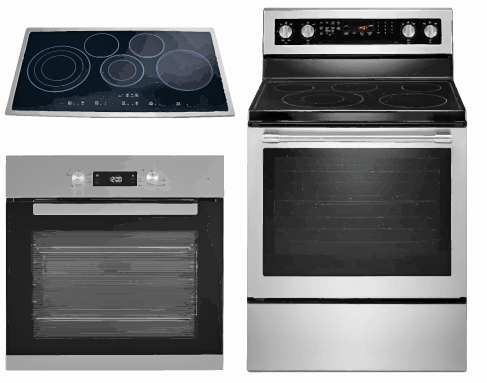Cooking appliances
Looking for an energy-efficient cooking appliance?

In Canada, cooking appliances - cooktops, ovens, ranges and microwave ovens - must meet minimum energy performance standards set by Canada’s Energy Efficiency Regulations.
Cooktops, ovens and ranges (except gas ranges) must also display an EnerGuide label that indicates how much energy the model uses.
Cooking appliance technology and energy efficiency
Today's cooktops, ovens and ranges are about as energy efficient as current technology allows. After adding better oven insulation and tighter-fitting oven doors, there are few ways left to increase the energy efficiency of these appliances.
Since the range of energy consumption between different models is small, there is no ENERGY STAR specification to qualify cooking appliances as high efficiency.
For more information, check out our Buying and operating tips page.
Use EnerGuide to compare energy efficiency

The EnerGuide label is mandatory for all cooking appliances in Canada except gas ranges. It must be easy to see on the outside or inside of the product.
The label shows the product type, model number and average energy consumption in kilowatt hours (kWh) per year. A scale shows how the model’s energy use compares with similar models: the lower the number, the more efficient the product.
Learn more about EnerGuide.
Check the "second price tag"
The first price tag is the sticker price. The second price tag is the appliance's annual or lifetime operating cost. Use NRCan’s calculator for new appliances to see the cost of operating a range for one year.
- Compare current models of all microwaves, cooktops, ovens and ranges available in Canada in our searchable product list.
Regulations set the energy efficiency minimum
All residential cooking appliances are subject to Canada’s Energy Efficiency Regulations, which set a performance standard for their energy consumption. This helps keep the least efficient products off the Canadian market.
- View the performance standards for microwave ovens, residential gas or electric ranges in Canada,
- Learn more about how Canada’s Energy Efficiency Regulations work.
Detailed information for manufacturers
Additional information for retailers
Types of cooktops
There are three general types of cooktops: gas, electric and induction. Gas cooktops heat food with flame and are perhaps the least efficient method of heating as much of the heat is lost to the air. Electric cooktops are more efficient than gas as more of the heat is transferred directly to the cooking surface. Electric cooktops encompass both open coil-type cooking tops and smooth cooking tops.
Although induction cooktops use electricity, they generate heat through electromagnets. Often praised for improving safety, increasing speed of cooking, providing greater control over temperature and being easier to clean, induction cooktops are considered one of the most efficient cooking technologies as they heat the cookware directly, not the surface beneath. The major drawback is that they require special types of cookware.
Types of ovens
Ovens typically fall into three main categories: electric, gas or microwave. Electric ovens are easy to use, easy to clean and the easiest to achieve even cooking. They are also available in both convection and conventional (conduction) varieties. With conventional ovens, the air around the food is heated to cook the food while convection ovens use fans to circulate the air. Convection ovens are more efficient as food is cooked faster and at a lower temperature, saving energy and money.
While gas stove are often touted for quick heating and better at retaining moisture, they tend to have hotspots and uneven heat and use a less clean source of fuel than electric types.
Microwave ovens are a type of electric oven that heat or cook food using microwave energy. They are very quick and energy efficient.
Page details
- Date modified: